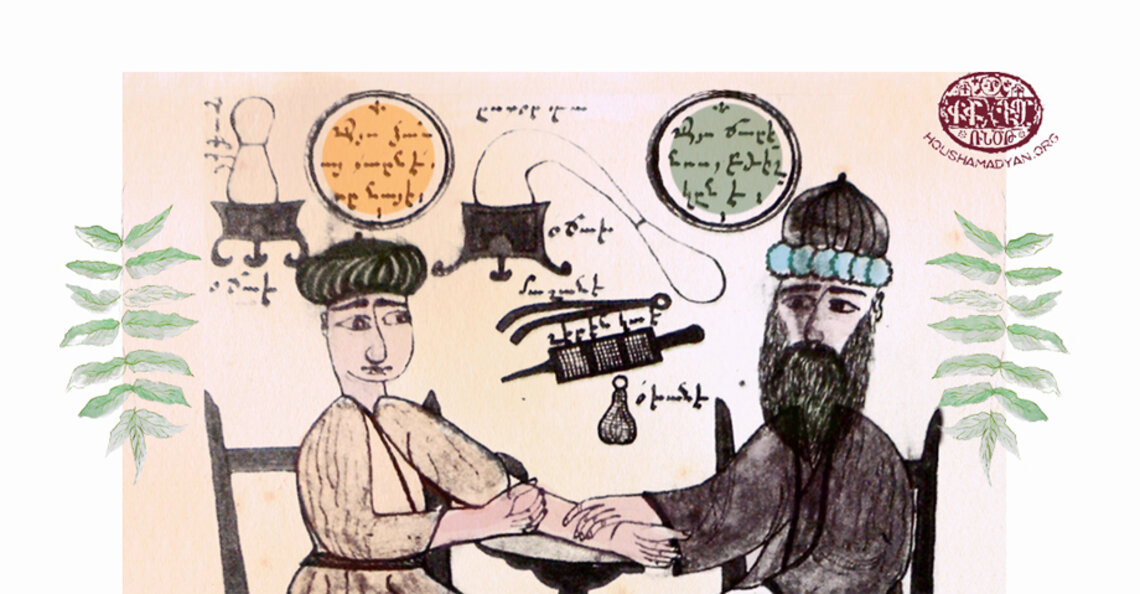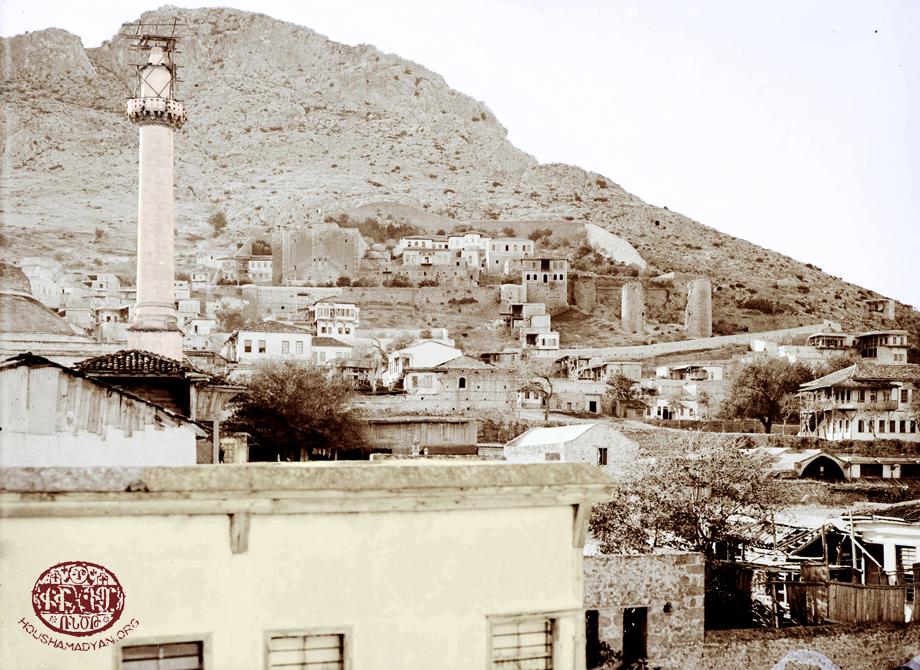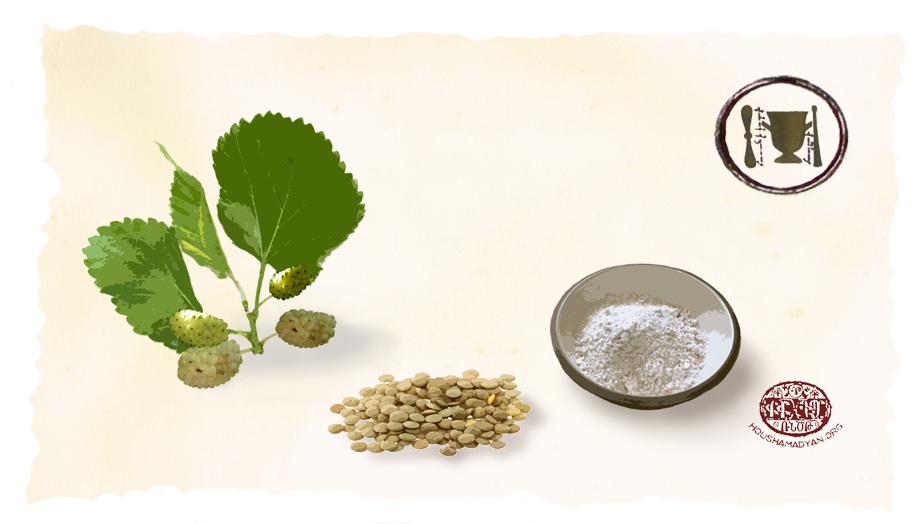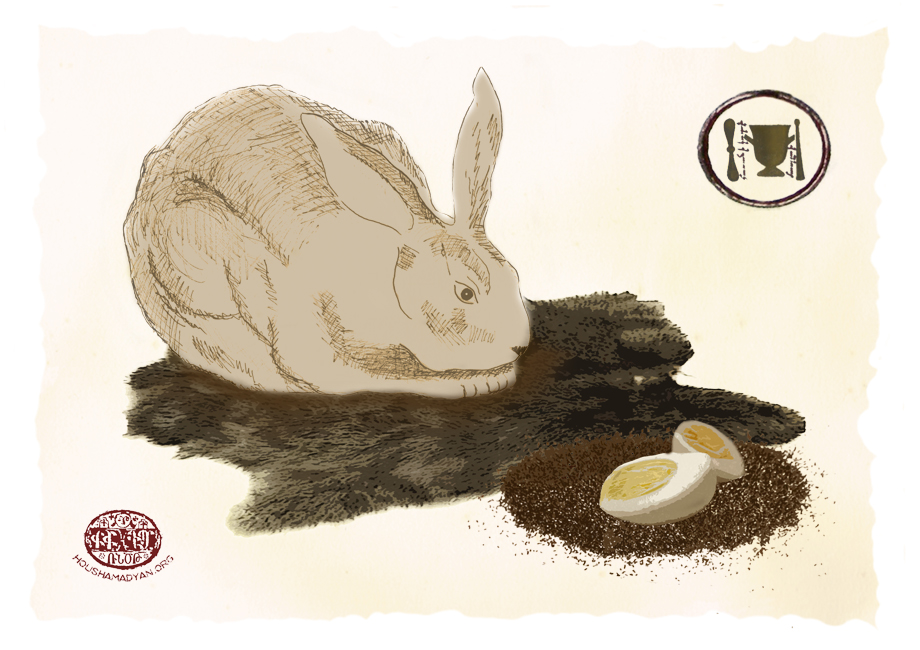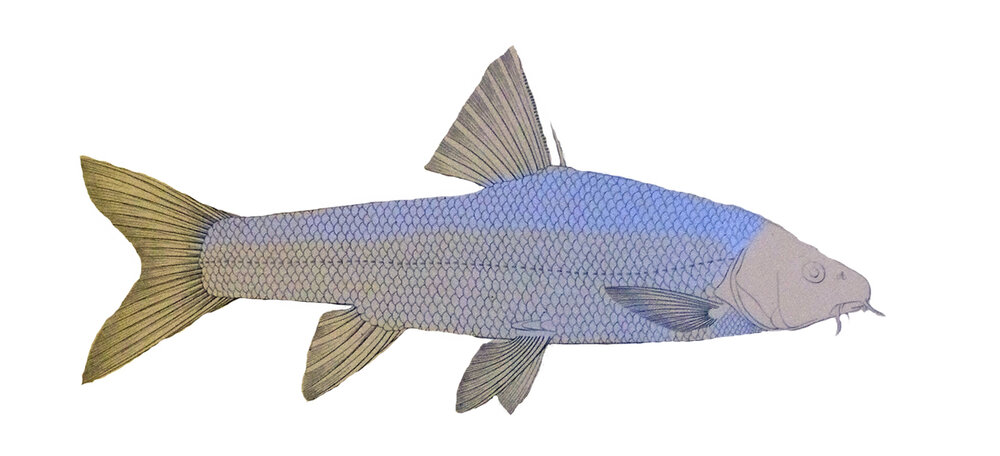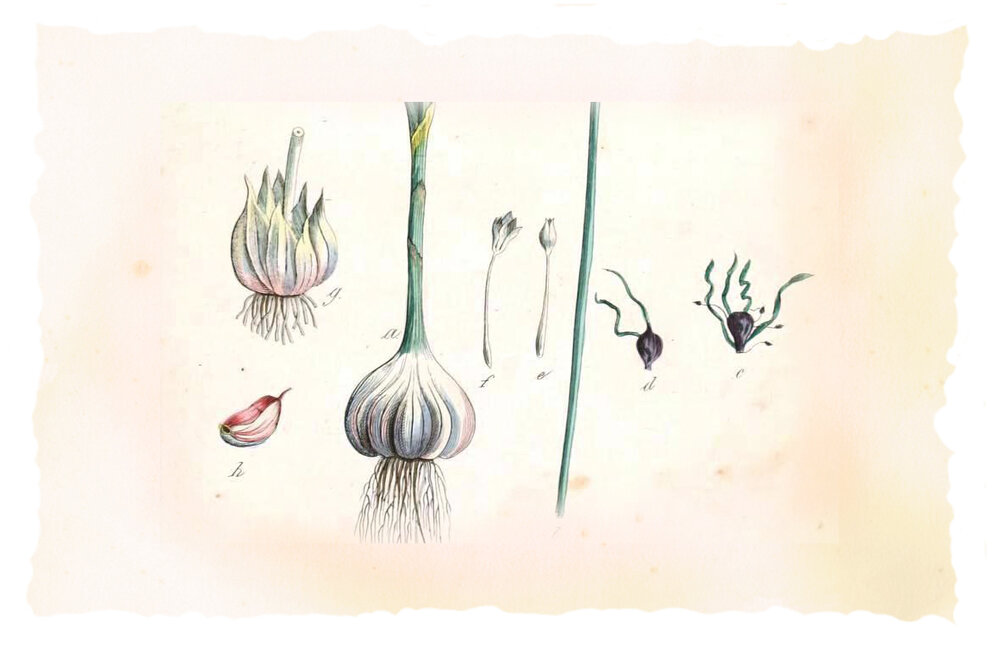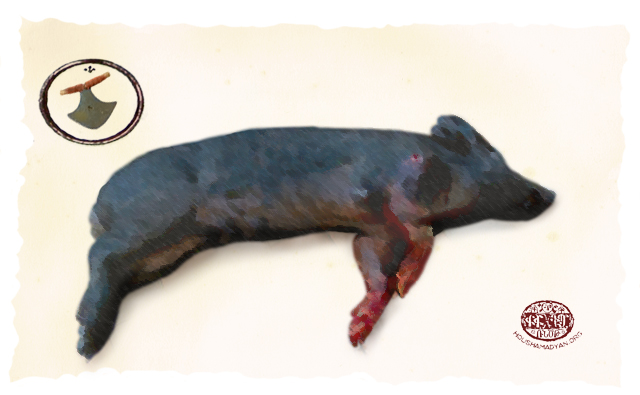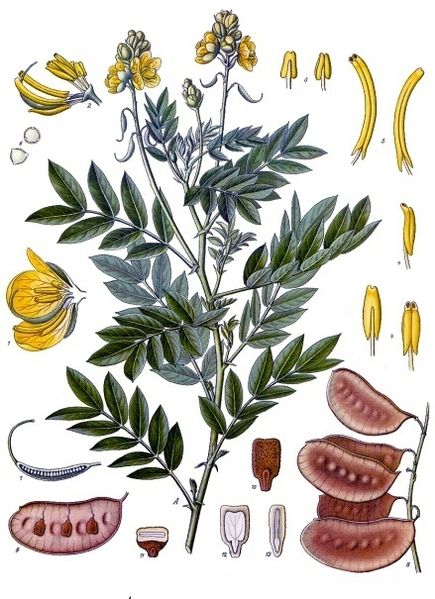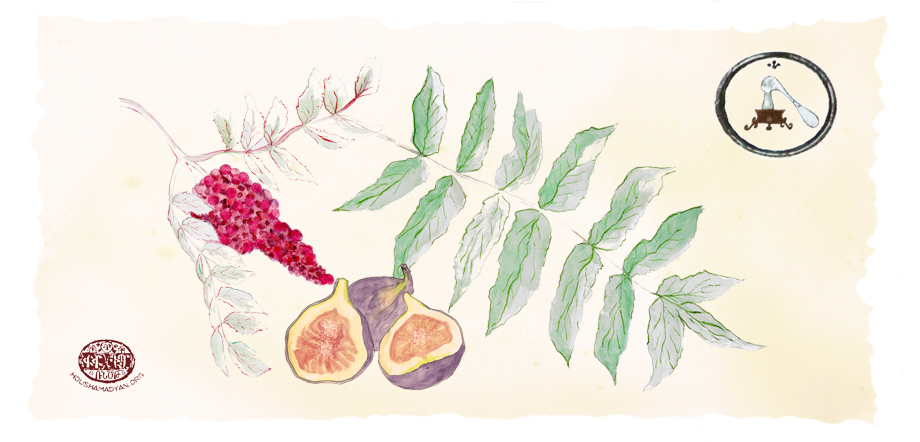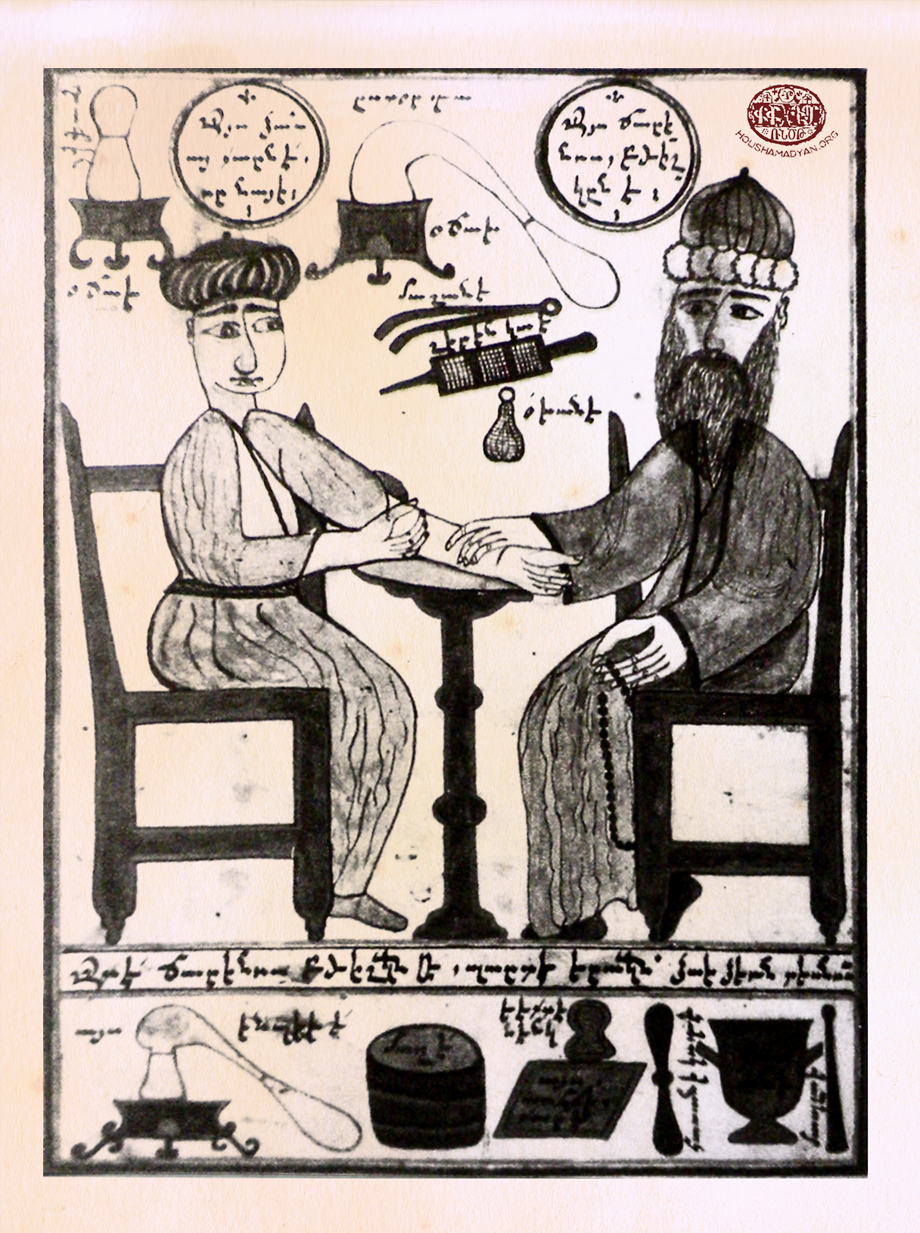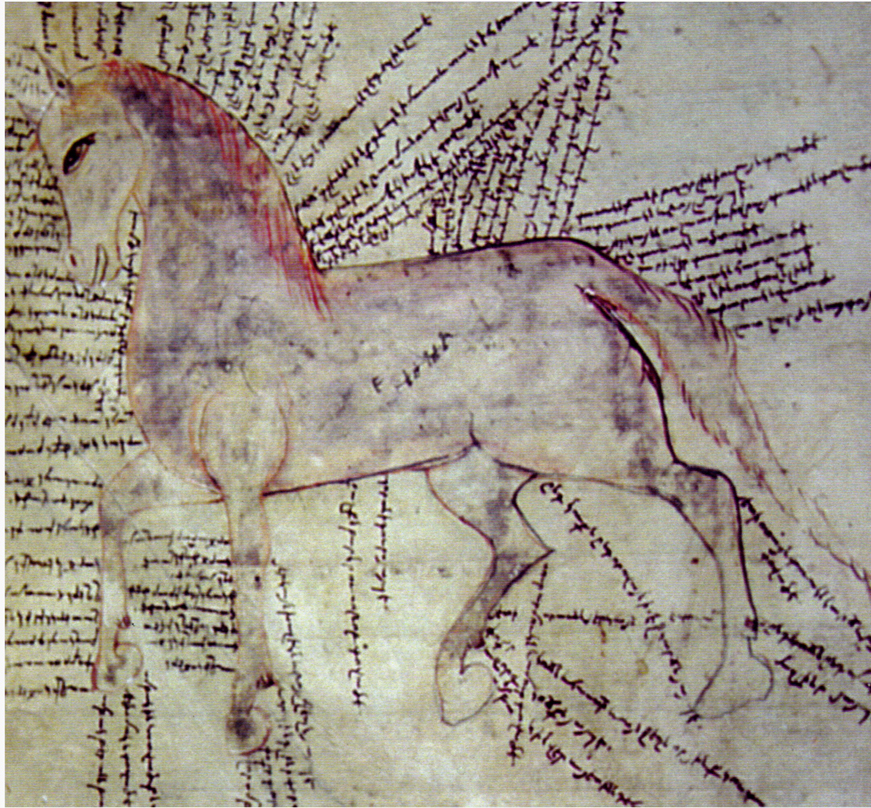Sis – Folk medicine
Author: V.Tachjian, 4/9/2013 (Last modified 4/9/2013)- Translator: Hrant Gadarigian
The town of Sis is known for its practitioners of folk medicine. In his work ‘Sis-Madyan’, Misak Keleshian provides varied information about folk medicine and its practitioners in the town. We know that it was only after 1850 that licensed physicians began to work in the town. They were government doctors that worked in Sis on a rotation basis. There is a reference to Armenian licensed physicians and pharmacists of Sis beginning in the 1890s. [1]
There were many medical terms in use here that were Turkish, given that they were also published in Turkish in the original sources. Armenians of Sis, also being Turkish speakers, used Turkish words for various diseases and their treatments. For the most part, we have given the Armenian synonyms next to the Turkish.
Beden Madyas
These are the lumps/swellings that crop up on the joints connecting the waist and the leg. The treatment is to take the leaves from a white mulberry tree, mix in lentils, and beat the mixture well. The, rye flour is added to the mixture and the final concoction is wrapped on the lump. After five to six hours the lumps opens, discharging pus mixed with blood. Recovery is perfect. Tvranda Kouyoumjian from Sis was famous for treating this malady. He also was skilled at treating bullet and knife wounds. For this, he would use cooked egg yolks that he would grind and place on the wound, to which he would add gun powder or some other drying agent. The entire concoction would be covered in a rabbit skin. [2]
Bonesetter (Turkish – çıkıkcı, sınıkci; Armenian – pegapuyj)
Sis was known for its expert bonesetters. Two such individuals were Mr. and Mrs. Mateos and Varvar Achabahian. Every day, people who had broken a leg or a hand would visit their house for treatment. The Achabahians would first wash the injury with hot water and unused soap. Then with a quick and powerful hand movement, they would snap the broken bone or injured joint back into place. This wasn’t the end of the treatment. The couple would then cover the injury with a prepared bandage composed of a mixture of oghi (vodka), egg whites and incense. Another bandage, also wrapped around the injury, consisted of cane shavings and bits of soap. They also were in the habit of treating bruised parts of the body with crushed raisins. After a few weeks or months, when the poultice separated from the body, it could be said that the bones had fully healed. The master bonesetter would then place a well beaten fish on the injury. The patient would also be given a fish to eat. Then, the bandages would be removed and the setting of the bones/joint would be repeated. [3]
Two other famous bonesetters in Sis were Hagop Agha Djeredjian and his son Sarkis. They were natives of Hadjin and pottery makers by trade. [4]
The deneci (experimenter)
In Sis, these individuals were the ones who removed bits of debris or crumbs of bread from the noses of children. They used a ten centimeter twig of cane just like a narrow pipe. Placing the twig near the nose cavity, the practitioner would either blow out or suck in. Hadji Sara was a famous Armenian deneci from Sis. Two Turkish practitioners, Elif and Eshe, were also prominent deneci. [5]
To Cauterize (Turkish – yakma; Armenian - kharan)
This form of folk medicine was used to treat joint pain, hernia, stroke, eye ailments, mouth deformities and arm immobility issues. The procedure was to light a match and open a wound of the skin right next to or exactly on the injured section. The general practice was also to make the wound either on the knee or above the elbow. Crushed garlic would be placed on the wound for 7-8 hours. Later, one chickpea would be placed on the wound, in addition to a green leaf from a grapevine, mulberry or sour orange tree. These ingredients would be changed anew throughout the day. Every day, pus would flow out of the wound. Treatment would continue until the pain disappears. There were cases when such treatment lasted for years, the procedure being repeated daily. [6]
Jaundice (Armenian – teghnoutiun, talgoutiun)
In Sis, the Sarekeshishian family (Margos, Haroutiun, Giragos and Nazar) was famous for treating this malady. The procedure was to slash the head a few times with a razor, thus letting blood flow. The wound would be rubbed with garlic. [7]
Throat Pain
The wife of Garabed Pashabezian (maiden name Achabahian) was well-known for treating this ailment. She was the sister of Catholicos Giragos II. It was a short but very delicate procedure. The practitioner would use a heated needle to burn the nerve located below the chin. There were two other cures for throat pain. The first used the breath of a dog. The patient’s mouth would be placed near that of a dog so that the patient could inhale the dog’s breathe. An even more superstitious treatment was to strangle a mole next to the patient. The practitioner would then place his/her hands on the patient’s throat, uttering the following – I strangled a mole and will now strangle you. [8]
Eczema (Turkish – temreyi; Armenian – trmor)
To treat this skin ailment, the practitioner would gather dirt from the bottom of an oven and mix in ground up cedar bark. The mixture would be placed on the affected area and covered. Another treatment was to extract the oils from various bushes, such as neem (azadirachta indica, Turkish - tespih) and buckthorn, boil it, and rub it on the skin. [9]
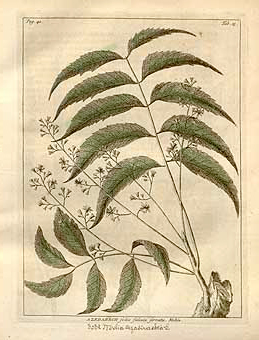
Body Aches or Redness
A razor blade is used to cause bleeding of the affected part of the body. A rabbit skin dipped in hot water is then applied to the area. [10]
Blisters/Boils (Armenian – pshdikner)
To remove these irritations, a heated needle is used to puncture the boil. The area is then covered with dough soaked in oil. [11]
Cough
Flowers called eshefatma or khtmieh are boiled and the liquid, to which sugar is stirred, is given to the patient to drink. Other treatments are to have the patient eat nöbetşekeri (Turkish for crystallized sugar), or to place a cotton cloth lined with black pepper and honey on the chest of the patient. [12]
Back Pain
A substance called djibar (a mixture of incense, cedar sap and black pepper) is rubbed on the painful areas. Other methods are “cupping therapy” and a massage with oil and black pepper. [13]
Fever
Seven to eight crushed garlic cloves are added to a cup of oghi (vodka). The cup is covered and allowed to stand overnight. In the morning, the patient drinks it down in one swallow. [14]
Internal Maladies and Pains
Earache
The liquid from a white onion is dripped into the painful ear. [16]
Toothache
The patient gargles with a mixture made of clove oil and vodka. Another remedy is to place a tobacco leaf on the painful tooth or to inhale tobacco smoke. [17]
Nausea
The patient drinks a mixture of boiled lemon and mint. [18]
Digestive Ailment
The patient drinks the boiled extract of cassia acutifolia (Turkish – sinameki) or similar roots. [19]
Diarrhea
The patient drinks an extract from ginger. The Turkish equivalent is zencefil/zencebil and the Armenian is dakgodj/godjabghbegh. Patients were also given the liquid attained after rice was boiled to drink. Another remedy was for the patient to swallow the flour made from ground oak acorns. The Armenian word is plourt/khozgaghin. [20]
Colic (Armenian - khit)
A heated brick is placed on the patient’s stomach. [21]
Lice
The remedy was to massage the hair with olive oil or a red powder called siurour. [22]
Dysentery (Turkish - iç ağrısı; Armenian – tanchk)
Typhoid (Turkish – terletme; Armenian – jandadent)
The remedy was to induce sweating by covering the patient in bed with layers of blankets or to place the feet in hot water. [24]
Tuberculosis (Turkish – ince ağrı; Armenian – tokakhd)
While rare, this was an incurable malady. The patient would be exposed to fresh air and fed a healthy diet. [25]
Malaria (Turkish – sıtma, Armenian – chermakhd)
This was a common disease in Sis. Getting the patient out in the fresh air was one remedy. Another supposed cure was to read passage from Nareg and the Bible over the patient. These books were also placed under the pillow of the ill. Another cure was called cherm gabel. A thin cotton thread was knotted three times and tied to the wrist of the patient. At the same time, the following Turkish words were chanted.
(Turkish)
- Kara eşeĝin saĝrısı,
- Hiç çıkmasın aĝrısı,
- Horoz öter, daha beter.
Translation:
- The tail of a black donkey (or backside)
- The pain will not pass
- The rooster crows worse.
Or:
(Turkish)
- Ey sıtma bu iti tutma,
- Tutarsan da bırakma.
Translation:
- O` malaria, don’t take hold of this dog
- But if you do, don’t let go.
Afterwards, the patient would light the end of the thread and would sniff. In the hope of a quick cure, patients afflicted with malaria would also tie pieces of cloth to roadside bushes believed to possess healing powers. [26]
Pleurisy (Turkish – satlıcan; Armenian goghatsav/goghakhit)
Pleurisy is an inflammation of the pleura, the lining surrounding the lings. It can lead to pneumonia (Armenian – tokadab). It was rare but deadly. The patient was kept warm enough to induce sweating. [27]
Cholera (Armenian – jandakhd)
This is another rare but devastating ailment. The patient would be quarantined and fed milk and yoghurt. [28]
Migraines (Turkish - yarımca; Armenian – klkhatsav)
They would place henna on the patient’s head and rub the forehead with vodka. The patient’s feet would be placed in a mustard plaster. Sometimes the patient was made to smoke the leaves of the ranunculus ficaria (lesser celandine) plant. The Turkish equivalent is mayasıl otu, and the Armenian – dzidzernakhod. Other folk cures included the patient placing the words written by a priest or hodja, or a talisman, under his hat. [29]
Mange (Turkish – uyuz; Armenian – kos)
To cure head mange, they would boil wheat germ and use the liquid to wash the patient’s head. Rash on other parts of the body were incurable. [30]
Eye Pain
This was a common ailment in Sis, especially in the summer and fall. The remedy was to use various drugs like baghlegh (potassium sulfate) or plant extracts. Another treatment was to place the following items on the affected eye – a gold coin, a piece of liver, tomato, egg oil. They would also drip watermelon juice in the eye or the breast milk from a mother who has borne a daughter. Another cure was to eat honey, beeswax and all, for several weeks. [31]
Measles (Turkish – kızamık; Armenian – garmroug)
The patient would not bathe for forty days, but must drink fruit syrup or lentil water for the entire period. [32]
Brain Fever (Turkish - beyin humması; Armenian – ougheghadab)
The treatment involved making the patient sweat. Those suffering from this ailment were sometimes tied up, given that they lost all reason and often attempted to flee. [33]
Spleen Ailment (Turkish – dalak; Armenian – paydzagh)
Such disorders are the result of chronic malaria. A belt is wrapped around the patient covering the spleen. They also would have the patient ride a horse and have master masseurs massage the stomach with water and soap. Another supposed cure was to have the patient, in a famished state, lied down on his/her back. A dish of boiling water would be placed on the belly button. [34]
Smallpox (Armenian – dzaghgakhd)
This disease had disastrous consequences up till around 1900, when a crude vaccination procedure reached Sis. The graft was performed by drawing pus from the wound of a sufferer. This would then be introduced into a wound opened on the body of a healthy person. [35]

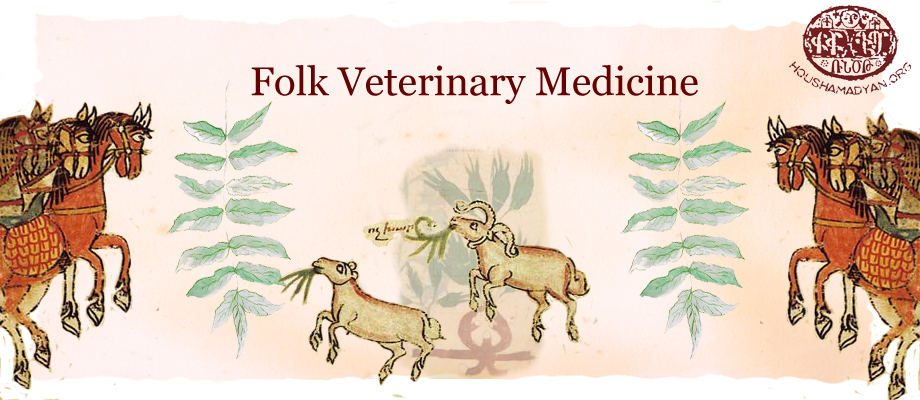
Misak Keleshian’s book also contains interesting information about local veterinary practices. Keleshian culled most of the information from Avedik Deovletian, who also hailed from Sis and later lived in Lebanon. Avedik, like his brother Deovlet, were famous veterinarians in Sis. Also well-known in the field were Hovhannes Chapoutian (Kel Vanes), Minas Yaghlian, Khacher Avsharian, Haroutiun Setian, Haroutiun Apartian and Hagop Pekmezdjian. [36]
Scrofula - a tuberculous infection of the lymph nodes in the neck
(Turkish – sıraca; Armenian – keghtsi porpokoum)
This disease could appear on any point of the body of a horse or donkey. The treatment was to remove the finger-sized glands on the right and left sides of the nose. The vet would make a cut on the outer portion of the snout with a knife and pull out the infected glands. The wound would be rubbed with salt. The wound would usually heal within a week. [37]
Hernia (Armenian – ichvatsk)
An animal with this ailment couldn’t eat barley because the gums on the upper jaw would be swollen, covering the top row of teeth, and making chewing impossible. The swollen gums would be pierced with a knife and covered with salt. This disease is unique to horses, donkeys and cows. [38]
Süleymani
This is a deadly disease. It is necessary to immediately draw blood from the aft haunches of the animal. Water is then boiled to which thyme is added. Boiled milk is added to this mixture and is fed to the sick animal. 15-20 raw eggs are also fed to the animal at the same time. When an animal is sick it is also fed a mixture of water and fresh human waste or the tobacco water from a hookah. The animal is made to run until it experiences diarrhea. [39]
Poor Digestion (Turkish – arpalamak)
Due to this affliction, the animal cannot digest barley, and stops eating and drinking altogether. The cure is to bathe the horse in cold water and to them feed it 20-30 raw eggs. They also dose the hooves with boiling water. [40]
Chronic glanders/farcy (Turkish – mankafa)
Stemming from catching cold, the animal suffers from a headache and cannot hold its head aright. The treatment is to mix four egg yolks in oil and to fill the horse’s nose and ears with the mixture and to have the animal run. [41]
Hoof damage (Turkish – mık deymek; Armenian – kami verk)
This occurs when the blacksmith mistakenly damages the horse’s hooves. Pus forms and the animal cannot walk. The remedy is to thoroughly wash the wound and to sprinkle them it with baghlegh (potassium sulfate) or to cover it with beeswax. Later, the beeswax is hardened with a flame and rubbed with tar (Turkish – katran, Armenian – khaydzghan) [42]
Lameness (Turkish – sakat)
This is a wound to the spine caused by carrying heavy items and extreme fatigue. The treatment is to melt tar in water and place the material on the painful area. The animal is not allowed to lie down, so a beam, suspended by two pieces of wood on either side tied to the ceiling with rope is fashioned. The animal thus is suspended off the ground. [43]
Difficulty urinating
Caused by catching a cold or other reasons. The animal experiences colic. The folk remedy was to urinate on the hooves or to constantly spin the animal around. [44]
Castration (Turkish - iğdiş etmek; Armenian – maloum)
Castration is usually confined to horses, oxen and goats. A male horse is made to lie down and its four legs are bound together. The veterinarian slits the scrotum skin and removes the testes. To stop the bleeding, the vet uses two pincer-like twigs to tie off the sperm ducts. A mixture of copper sulfate (Turkish – göztaşı), potassium sulfate and salt is applied to the wound. [45]
Yelkafa
It’s an injury to the hind hipbone, which prevents the horse from walking. The remedy is to use a skewer and to make a circular brand around the painful area. The veterinarian then pierces the center of the circle with the skewer, thrusting from the bottom of the skin to the top. [46]
Snake Bite
A knife is used to cut the bite area and a mixture of crushed garlic and yogurt is rubbed. When a yellowish liquid flows, it means the venom is coming out. [47]
Bıçırgan
This is a wound that appears on the inner part of a horse’s hind hoof. The cure is to rub the area with tahin (sesame paste) and to keep it there for 24 hours. The wound is then thoroughly washed with water and a mixture of potassium sulfate and tar is rubbed on. [48]
Itch (Turkish – gicimik; Armenian – kervudouk)
The itchy spot is washed thoroughly with soap and hot water. Sulfur (Armenian - dzdzoump) powder is mixed with oil and the paste is rubbed on the affected area. [49]
Limping (Turkish – aksamak; Armenian – gaghal)
The painful area is washed with hot water and soap. Then, equal amounts of pure alcohol and kefir are mixed, to which is added a raw egg. The mixture is brought to a boil and left to cool. The paste is then massaged into the painful areas of the animal. [50]
A cold (Turkish - donun olmak)
The horse must be branded with a hot skewer in 24 spots – three in each of the inner layers of the hind hooves, three on both sides of the neck, three around each eye, and three around each ear. [51]
Painful Subcutaneous Tumor (Turkish – yanıkara)
This is a skin disease that appears on the upper areas of the forelegs that makes walking difficult. The cure is to make furrow like and parallel cuts on the affected skin. Then, using the tips of the fingers, the vet makes holes under the skin to connect the furrows. The unclean blood is thus allowed to flow out. [52]
Köta
This is an ailment that appears on the cow’s utter and a horse’s stomach. It causes extreme pain and itching, and the affected area swells up. The treatment is to rub a mixture of vinegar and bolus armenus/bole armoniac (Turkish - kil ; Armenian – haygavi), an earthy clay, usually red, native to Armenia. [53]
Chatlak (çatlak)
These are tiny gland-like lumps that appear on the inner portions of the animal’s legs or on the knees. The remedy is to slice the growths with a knife and to remove the inflamed glands by hand. [54]
To impregnate a sterile horse
The uterus of the horse is cleaned with a cloth. Then a lead bullet is wrapped in roll and placed in the uterus. Thus, during intercourse, the embryo doesn’t entirely flow out. It gets stuck to the wool and causes pregnancy. [55]
Tabak
This is a wound that appears on the tongue or the foot extremity of an animal. The remedy is to boil a mixture of baghlegh (potassium sulfate) and copper sulfate (Turkish - göztaşı) and to rub it on the tongue. Another method is to wash the wound in boiled sumac (Armenian – aghdor) water. To treat the feet, a mixture of potassium sulfate and tar is rubbed on the affected area. [56]

- (1) Misak Keleshian, Սիս-Մատեան [Sis-Madyan] [Sis-Book] (Beirut: HayDjemaran, 1949), pp. 333-341.
- (2) Ibid., p. 403
- (3) Ibid., p. 404
- (4) Ibid
- (5) Ibid
- (6) Ibid
- (7) Ibid
- (8) Ibid., p. 405.
- (9) Ibid
- (10) Ibid
- (11) Ibid
- (12) Ibid
- (13) Ibid
- (14) Ibid
- (15) Ibid
- (16) Ibid
- (17) Ibid
- (18) Ibid., p. 406
- (19) Ibid
- (20) Ibid
- (21) Ibid
- (22) Ibid
- (23) Ibid
- (24) Ibid
- (25) Ibid
- (26) Ibid
- (27) Ibid
- (28) Ibid
- (29) Ibid
- (30) Ibid
- (31) Ibid., p. 407
- (32) Ibid
- (33) Ibid
- (34) Ibid
- (35) Ibid
- (36) Ibid., p. 408
- (37) Ibid
- (38) Ibid
- (39) Ibid
- (40) Ibid
- (41) Ibid
- (42) Ibid
- (43) Ibid
- (44) Ibid
- (45) Ibid
- (46) Ibid., pp. 408-409
- (47) Ibid., p. 409
- (48) Ibid
- (49) Ibid
- (50) Ibid
- (51) Ibid
- (52) Ibid
- (53) Ibid
- (54) Ibid
- (55) Ibid
- (56) Ibid

